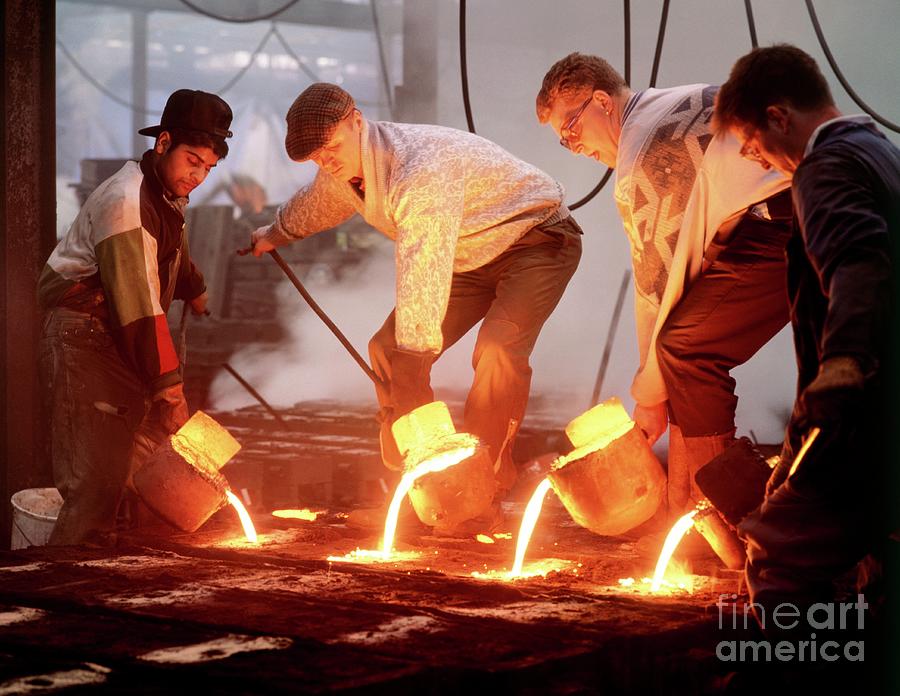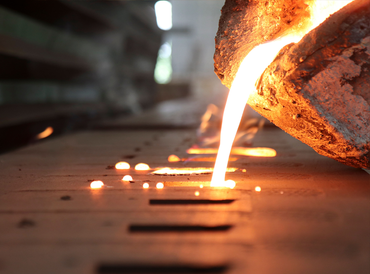How a Metal Foundry Combines Artistry and Precision
Wiki Article
Everything About Metal Casting: Exactly How Foundries Supply Top Quality and Precision in Manufacturing
Metal casting stands as a foundational procedure in production, where raw metals are changed into specific elements. Foundries use various casting techniques to accomplish wanted features and shapes. Each technique features its own collection of restrictions and benefits. Understanding these subtleties is vital for valuing exactly how high quality and precision are kept throughout the process. The conversation in advance will certainly check out the detailed dynamics of metal casting and its importance throughout numerous sectors.The Basics of Metal Casting
Metal casting is a basic procedure in manufacturing that includes forming liquified metal into preferred kinds. This important strategy begins with the choice of basic materials, often different metal alloys, which are thawed in a furnace. When the metal gets to the ideal temperature, it becomes fluid and all set for casting.The procedure needs a mold, commonly made from sand, metal, or ceramic, which defines the last shape of the cast item. As soon as the molten metal is poured right into the mold, it cools down and strengthens, handling the mold's contours.
After cooling, the casting is removed from the mold, and any necessary finishing procedures, such as cutting or brightening, are performed. This technique enables makers to generate complex forms and parts with high precision and marginal waste. Metal casting is extensively utilized across different sectors, from automotive to aerospace, highlighting its value in modern production.
Kinds Of Casting Methods
While various casting techniques exist, each method uses unique advantages and is fit for various applications. Sand casting, one of one of the most typical approaches, makes use of sand as the mold material, permitting intricate layouts and huge parts. Investment casting, recognized for its precision, employs a wax pattern covered in ceramic, making it optimal for complex geometries. Pass away casting, which involves requiring molten metal right into molds under high stress, is frequently utilized for mass production of tiny, in-depth parts. Furthermore, covering molding integrates sand and resin to create thinner, a lot more accurate mold and mildews, improving surface area finish. An additional technique, continual casting, allows the production of lengthy lengths of metal shapes, enhancing manufacturing processes. Each of these methods plays a critical duty in the metal casting industry, attending to specific requirements from manufacturing quantity to develop intricacy, therefore adding to the variety of applications throughout numerous industries.The Function of Foundries in Production
Foundries serve a crucial function in the production landscape, as they transform raw steels into usable elements through numerous casting processes. These centers utilize a variety of methods to produce items that fulfill precise specs, therefore guaranteeing high quality and effectiveness in manufacturing (Aluminum Casting). By utilizing methods such as sand casting, investment casting, and die casting, shops satisfy varied sectors, consisting of auto, aerospace, and building and construction
Ultimately, foundries are indispensable to the production community, providing critical parts that support a wide selection of applications and sectors. Their precision and adaptability drive performance in contemporary manufacturing.
Materials Used in Metal Casting
The option of materials utilized in metal casting is essential for accomplishing the preferred residential properties and performance of the end product. Various steels such as bronze, light weight aluminum, and iron are typically utilized, each offering distinctive advantages. Aluminum is favored for its light-weight and corrosion-resistant qualities, making it optimal for auto and aerospace applications. Iron, particularly cast iron, is understood for its exceptional fluidness and toughness, suitable for heavy machinery and facilities parts. Bronze, with its remarkable wear resistance, is usually made use of in aquatic settings.In addition, products such as silica sand are regularly made use of for mold and mildew production, giving a great equilibrium in between durability and ease of shaping. The choice of materials also consists of ingredients like changes, which boost the casting procedure by boosting fluidness and minimizing oxidation. Inevitably, the ideal option of these products substantially affects the performance and high quality of the casting procedure.
High quality Control in the Casting Process
Quality control in the casting process is necessary to ensure that end products satisfy market criteria and specs. Numerous assessment methods are employed to identify issues and examine the stability of cast components. In addition, adherence to developed certifications and criteria improves the dependability and efficiency of cast materials.Inspection Techniques Employed
Maintaining the honesty of actors metal elements relies greatly on numerous examination techniques. Foundries use aesthetic assessments as a preliminary measure to recognize surface problems, such as cracks or inclusions. Non-destructive testing (NDT) approaches, including ultrasonic screening and radiographic inspection, are crucial for detecting inner defects without endangering the element's integrity. Dimensional evaluations utilizing calipers and coordinate measuring devices verify that components satisfy defined resistances. In addition, chemical evaluation verifies that the alloy structure straightens with needed requirements. These evaluation strategies collectively validate that the spreadings meet the needed quality and performance requirements, inevitably reducing the danger of failing in their intended applications. Carrying out these strenuous inspections is essential for keeping high criteria in metal casting production.Criteria and Certifications
Specifications and certifications play a vital duty in the quality assurance of the casting process. Foundries stick to different worldwide and industry-specific requirements, such as ISO 9001 and ASTM guidelines, guaranteeing consistency and reliability in their products. These standards describe the required requirements for materials, manufacturing techniques, and screening procedures, adding to a much more reliable production process. Accreditations, such as AS9100 for aerospace applications, additionally highlight the value of check here quality control in specialized markets. By acquiring these qualifications, factories demonstrate their commitment to quality, boosting and lowering issues consumer satisfaction. Normal audits and inspections validate conformity, promoting constant improvement and innovation within the industry. Inevitably, adherence to developed requirements grows depend on in between producers and clients.Developments in Casting Technology

3D Printing Integration
Integrating 3D printing innovation right into metal casting procedures is revolutionizing the manufacturing landscape. This ingenious combination improves the layout and manufacturing of intricate geometries that traditional methods struggle to accomplish. By using additive production for developing cores and mold and mildews, shops can substantially reduce lead times and material waste. 3D printing enables for fast prototyping, making it possible for suppliers to examine layouts swiftly and effectively, therefore promoting repetitive enhancements. This innovation likewise supports the production of lightweight components, which are essential in industries such as aerospace and auto. As an outcome, the combination of 3D printing not only streamlines procedures however additionally elevates the precision and quality of actors metal products, marking a significant improvement in the market.Automated Manufacturing Processes
The improvements in 3D printing have actually led the way for more advancements in automatic production procedures within metal casting. Foundries are progressively adopting robotics and automation to enhance performance and precision. Automated systems simplify the whole casting process, from mold creation to pouring and finishing. Smart sensors and real-time surveillance permit precise control of temperatures and product flow, reducing waste and enhancing quality. Furthermore, software options facilitate much better layout and simulation, enabling makers to optimize procedures prior to production starts. These computerized production procedures not just decrease labor expenses but likewise decrease human error, making sure regular output. Because of this, the assimilation of advanced innovations in metal casting is transforming manufacturing capacities and meeting the growing needs of various industries.Advanced Product Development
As sectors require greater performance and sustainability, developments in product growth for metal casting are becoming a critical emphasis. Scientists and designers are checking out new alloys and composites that improve mechanical residential properties while minimizing environmental influence. Innovations consist of light-weight products that keep toughness, enabling far better gas effectiveness in transportation applications. Furthermore, the unification of recycled products is this article ending up being a lot more widespread, aligning with sustainability objectives. Advanced casting techniques, such as 3D printing and precision molding, enable for the creation of intricate geometries that traditional techniques can not achieve. These advancements not just enhance the performance of cast components but likewise boost manufacturing effectiveness. Overall, the continuous evolution of product scientific research drives the future of metal casting, meeting the demands of modern sectors.
Applications of Metal Casting Throughout Industries
Metal casting plays a vital duty in various industries, as it enables the production of complicated forms and high-quality components with relative effectiveness - Aluminum Casting. In the auto industry, cast steels are vital for creating engine blocks, transmission situations, and other vital parts that need durability and precision. Aerospace industries use metal casting for elements like generator blades and architectural components, where reliability is vitalAdditionally, equipment and devices manufacturing gain from metal casting by generating equipments, housings, and other intricate parts that enhance functionality. The building industry additionally uses metal casting for architectural attributes, architectural assistances, and fittings, showcasing flexibility.
In addition, the medical field counts on cast metals for surgical instruments and implants, emphasizing the demand for biocompatibility. On the whole, metal casting is a foundational procedure throughout numerous markets, giving solutions that satisfy rigid quality requirements and efficiency needs.
Frequently Asked Concerns
What Safety And Security Procedures Are Absorbed Metal Casting Foundries?
In metal casting foundries, safety and security steps include safety gear, air flow systems, regular equipment upkeep, staff member training, and emergency protocols to mitigate risks connected with high temperatures, unsafe materials, and possible mishaps during the casting procedure.How Do Foundries Take Care Of Waste and Environmental Impact?
Foundries take care of waste and ecological influence through recycling materials, executing filtering systems for emissions, and sticking to guidelines - Aluminum Foundry. They likewise take on lasting techniques, such as minimizing power usage and utilizing environment-friendly materials in their processesWhat Are the Expenses Linked With Metal Casting Procedures?
The expenses connected with metal casting processes include basic materials, labor, equipment maintenance, power usage, and waste management. Furthermore, variations in market value and compliance with environmental guidelines can substantially impact total costs for foundries.Just How Does Metal Casting Compare to Other Production Approaches?
Metal casting supplies distinct advantages, such as intricate shapes and high material efficiency, compared to approaches like machining or stamping. It may entail much longer lead times and greater preliminary expenses, depending on job specs.
What Profession Opportunities Exist in the Metal Casting Market?
The metal casting industry offers various job possibilities, consisting of shop administration, process engineering, quality control, mold and mildew design, and maker procedure. Specialists can likewise seek duties in research and growth, sales, and environmental wellness and safety and security.Metal casting stands as a fundamental procedure in manufacturing, where raw steels are changed right into details parts. Metal casting is a basic procedure web link in making that includes forming liquified metal right into desired kinds. One more technique, continuous casting, enables the manufacturing of long sizes of metal shapes, streamlining manufacturing procedures. The costs linked with metal casting processes include raw products, labor, equipment maintenance, energy intake, and waste monitoring. The metal casting market uses different job chances, consisting of factory administration, process design, quality assurance, mold layout, and maker procedure.
Report this wiki page